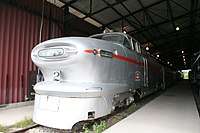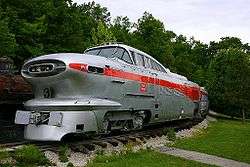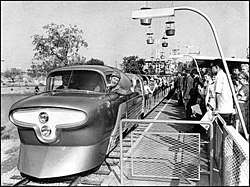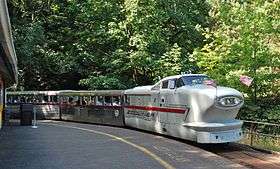Aerotrain (GM)
The Aerotrain was a streamlined trainset that the General Motors (GM) Electro-Motive Division (EMD) introduced in 1955.[1][2] GM originally designated the light-weight consist as Train-Y (Pullman-Standard's Train-X project was already underway) before the company adopted the Aerotrain marketing name.[2]
.jpg)
Design and components
GM's Styling Section first brought the Aerotrain's trainset to life, as it did for all of GM's body designs of that mid-century era. Chuck Jordan was in charge of designing the Aerotrain as Chief Designer of Special Projects.[2] GM constructed two Aerotrains, each of which utilized one of the last two (serial numbers 21463 and 21464) of three experimental diesel–electric EMD LWT12 power cars[3] that the company built.[4]
GM based the EMD LWT12's power components on those in the EMD SW1200 switcher. Like the SW1200, the LWT12 utilized the company's model EMD 567C 12-cylinder prime mover that could produce 1,200 horsepower.[5] The power car featured a cab that mimicked an aircraft's cockpit. The locomotive's overall design resembled that of recent automobiles available for sale at the time.[2]
The company completed the Aerotrains by coupling each of the two locomotives to sets of ten modified GM Truck & Coach Division 40-seat intercity highway bus bodies. Like GM's new PD-4501 Scenicruiser buses, the Aerotrain's passenger cars had windows with slanted sides.[2][5][6] The finned back end of the train resembled the rear of a 1955 Chevrolet or Pontiac station wagon.[7] The cars each rode on two axles with an air suspension system that was intended to give a smooth ride, but had the opposite effect.[2][8]
The cars were 40 feet long, half the length of standard designs, thereby reducing the weight by 50%. To further reduce weight, GM built the locomotive and cars of each train from aluminum.[2]
GM returned to a concept first used at the start of the streamliner era, semi-permanently coupled trainsets. All of the cars and locomotive shared a truck, which further helped to reduce weight.[2]
History
Pennsy Aerotrain[9] | |||||||||||||||||||||||||||||||||||||||||||||||||||||||||||||||||||||||||||||||||||||||||||||||||||||||||||||||||||||||||
|---|---|---|---|---|---|---|---|---|---|---|---|---|---|---|---|---|---|---|---|---|---|---|---|---|---|---|---|---|---|---|---|---|---|---|---|---|---|---|---|---|---|---|---|---|---|---|---|---|---|---|---|---|---|---|---|---|---|---|---|---|---|---|---|---|---|---|---|---|---|---|---|---|---|---|---|---|---|---|---|---|---|---|---|---|---|---|---|---|---|---|---|---|---|---|---|---|---|---|---|---|---|---|---|---|---|---|---|---|---|---|---|---|---|---|---|---|---|---|---|---|---|
| |||||||||||||||||||||||||||||||||||||||||||||||||||||||||||||||||||||||||||||||||||||||||||||||||||||||||||||||||||||||||
In late February 1956, the Pennsylvania Railroad began operating the first Aerotrain trainset (the Pennsy) between New York and Pittsburgh. In June, the Pennsylvania cut back its New York-Pittsburgh Aerotrain to travel only between Philadelphia and Pittsburgh.[7]
General Motors demonstrated the second Aerotrain trainset on several railroads, including the Atchison, Topeka and Santa Fe Railway, where the train operated in California between Los Angeles and San Diego as a San Diegan. During the demonstration period, the New York Central Railroad operated the train between Chicago and Detroit. From July to October, the New York Central ran the train between Chicago and Cleveland.[7]
In December 1956, the Union Pacific Railroad began to operate the second trainset between Los Angeles and Las Vegas as the City of Las Vegas, but discontinued that service in October 1957.[7][10] The Pennsy continued to run between Philadelphia and Pittsburgh until June 1957, after which time it joined the Union Pacific train in City of Las Vegas service.[7]
In October, 1958, General Motors sold both trainsets to the Chicago, Rock Island and Pacific Railroad (the Rock Island line), which designated their locomotives as numbers 2 and 3 while using both trainsets in commuter service between Chicago and Joliet.[7][11] Both trainsets ended service in 1966. Although the Rock Island scrapped or re-used most of the trainsets' equipment, both locomotives and two pairs of coaches remain on display in museums.[7]
Meanwhile, the first EMD LWT12 locomotive (serial number 20826), began in February 1956 to travel on the Rock Island line between Chicago and Peoria when pulling the line's Jet Rocket train, which bore a strong resemblance to an Aerotrain.[4][12][13] The Rock Island later designated the power car as locomotive number 1.[14]
The American Car and Foundry Company constructed the Jet Rocket's coaches, most of which were similar, but not identical, to those of the Talgo II.[12] The last car resembled that of the future Talgo III.[12]
Unlike the slanted sides of the windows on the Aerotrain's ten coaches,[2] the windows on the Jet Rocket's twelve coaches had vertical sides.[12] In addition, the Jet Rocket's Talgo-like coaches had one axle,[15] whereas the Aerotrain's coaches had two.[8]
After less than two years, the Rock Island shortened the Jet Rocket's route. The train then traveled only between Chicago and Joliet. The railroad scrapped the train several years later.[12]
GM's "lightweight with a heavyweight future" was introduced at a time when passenger train revenues were declining due to competition from airlines and private automobiles. Although they featured a streamlined design, the Aerotrains failed to capture the public's imagination. Their cars, based on GM's bus designs and using an air cushioning system, were rough riding and uncomfortable. The design of the locomotive section made routine maintenance difficult and it was underpowered.[16]
Originally intended to travel at speeds of up to 100 mph (161 km/h), modifications reduced the Aerotrain's maximum speed to 80 mph (129 km/h), which it was able to achieve when traveling on level ground without passengers during the train's demonstration period.[17][18] However, an Aerotrain's LWT12 power car required the assistance of a 1,750 horsepower EMD GP9 switcher locomotive when pulling the train's ten passenger cars up Southern California's Cajon Pass while leading the Union Pacific's City of Las Vegas.[17] Uncomfortable riding conditions associated with the Aerotrain's higher speeds later prompted the Rock Island line to restrict its two cheaply-purchased Aerotrains to low-speed commuter service in and near Chicago.[17]


The EMD LWT12 locomotives and two passenger cars of each of the two Aerotrains that GM constructed are presently on display within the United States.[16] The National Railroad Museum in Green Bay, Wisconsin, now exhibits the Rock Island line's Aerotrain locomotive number 2 and two of its coaches (parts of trainset number 2).[2][16][19] The Museum of Transportation in Kirkwood, Missouri (near St. Louis) exhibits the Rock Island's Aerotrain locomotive number 3 and two coaches (parts of trainset number 1).[2][7][16][20]
Disneyland had a scale version of the Aerotrain, known as the Viewliner, from 1957 to 1959 (see below).[16] Since 1958 the Washington Park and Zoo Railway in Portland, Oregon, has operated a scale, diesel-powered replica of the Aerotrain (dubbed the Zooliner) to transport zoo visitors.[16] Idlewild Park in Reno, Nevada, operates a small train whose locomotive is fashioned after that of the Aerotrain.[16][21]
The Viewliner

On June 26, 1957, the narrow-gauge Santa Fe and Disneyland Viewliner (billed by Disneyland as "the fastest miniature train in the world") commenced operation. Two separate trains, designed and built as scale replicas of the futuristic Aerotrain, traveled a figure-eight track through parts of Tomorrowland and Fantasyland parallel to a portion of the DLRR main line. The Tomorrowland train featured cars that were named for the planets while the cars of the Fantasyland train were named after various Disney characters.
The modern, streamlined trains were placed in service to represent the future of rail travel in contrast to the steam-powered DLRR which represented its past. Motive power for each train consisted of an integral head-end unit driven by an Oldsmobile "Rocket" V8 gasoline engine. Oldsmobile also furnished the windscreen, doors and instrument console for each of the two 5,000 lb (2,300 kg) locomotives. The attraction operated until September 15, 1958, when construction began on the Matterhorn and Submarine Voyage; the Disneyland Monorail System took the place of the Viewliner in June of the following year.
The Zooliner

The Zooliner, one of three trains on the Washington Park and Zoo Railway operating in the Oregon Zoo in Portland, is a 5/8-scale replica of the Aerotrain. The Zooliner entered service in 1958.[22] On June 14, 2008, the zoo held a "50th Birthday" celebration for the locomotive.[23] The Zooliner remains the primary train for the zoo.[24]
See also
- Train-X, a lightweight, all aluminum train produced by the Pullman Company. They were used by the New York Central Railroad in Ohio on the Xplorer, and the New York, New Haven and Hartford Railroad on the Dan'l Webster between New York and Boston.
References
- "Here Comes Tomorrow --- Fast". Advertisement by General Motors Electro-Motive Division. Saturday Evening Post. December 10, 1955. p. 89. Archived from the original on July 17, 2011.
- "GM's "Aerotrain": History And Operation". American-Rails.com. Retrieved May 13, 2020. Archived May 13, 2020, at the Wayback Machine.
- U.S. Patent D177,814
- (1) Bradley, William H. (May 24, 2014). LWT12. DCC Dictionary 1.0. Morrisville, North Carolina: Lulu Press. ISBN 1304905748. Retrieved May 15, 2020 – via Google Books.
Only three LWT12 units were built. First one, EMD serial number 20826, entered service with the Chicago, Rock Island and Pacific Railroad to pull the "Talgo Jet Rocket" train between Chicago and Peoria. Second and third units, EMD serial numbers 21463 and 21464, became integrated into the Aerotrain. Two of the three LWT12 locomotives are now in the care of museums.
(2) Marre, Louis A. (1982). Rock Island diesel locomotives, 1930-1980. Cincinnati, Ohio: Railfax. p. 20. ISBN 0942192001. LCCN 82003744. OCLC 565027875. Retrieved May 15, 2020 – via Google Books.
(3) Bachand, Jean-Denis (February 15, 2008). "EMD LWT-12". thedieselshop.us. Retrieved May 15, 2020. Archived May 15, 2020, at the Wayback Machine. - (1) Bradley, William H. (May 24, 2014). LWT12. DCC Dictionary 1.0. Morrisville, North Carolina: Lulu Press. ISBN 1304905748. Retrieved May 15, 2020 – via Google Books.
(2) Bachand, Jean-Denis (February 15, 2008). "EMD LWT-12". thedieselshop.us. Retrieved May 15, 2020. Archived May 15, 2020, at the Wayback Machine - U.S. Patent D179,006
- "The Aerotrain". Streamliner Memories. February 28, 2013. Retrieved May 12, 2020. Archived May 13, 2020, at the Wayback Machine.
- O'Clair, Jim. "The GM Aerotrain: Stylistically successful but a financial boondoggle". Hemmings Feature (from February 2010 issue of Hemmings Motor News). Retrieved May 15, 2020.
- Timetable Treasury. New York: Wayner Publications. 1979. p. 141.
- (1) Solomon, Brian. Union Pacific Railroad. Voyageur Press. p. 87. ISBN 978-1-61060-559-5 – via Google Books.
(2) "Union Pacific Railroad Aerotrain operating as the "City of Las Vegas"" (photograph). Retrieved July 19, 2020 – via Pinterest. - (1) Marvel, Bill (2013). The Rock Island Line. Bloomington, Indiana: Indiana University Press. pp. 122, 126–129. ISBN 978-0-253-01127-5. LCCN 2009036056. OCLC 854521704. Retrieved July 20, 2020 – via Google Books.
(2) "The Rock Island line's Aerotrain No. 2 leaving Chicago rail yard in 1962" (photograph). Retrieved July 20, 2020 – via Blogspot.com. Archived July 20, 2020, at the Wayback Machine
(3) "The Rock Island line's Aerotrain No. 3 in Chicago rail yard" (photograph). Retrieved July 19, 2020 – via Pinterest. - "The Jet Rocket". Streamliner Memories. March 1, 2013. Retrieved May 12, 2020. Archived May 13, 2020, at the Wayback Machine.
- Longmire, Steve (February 1956). "Peoria's Jet Rocket Train" (7 photographs). Retrieved June 6, 2020 – via Flickr. Archived June 6, 2020, at the Wayback Machine.
- "EMD LWT12 locomotive No. 1 (serial number 20826) pulling the Jet Rocket on the Chicago, Rock Island and Pacific Railroad" (photograph). Retrieved May 4, 2020 – via Flickr. Archived May 4, 2020, at the Wayback Machine.
- Guillén, Mauro F. (2001). The Limits of Convergence. Princeton, New Jersey: Princeton University Press. p. 104. ISBN 0-691-05705-2. Retrieved May 4, 2020 – via Internet Archive.
In addition, the cars would ... have only one axle with two wheels at the rear end, while the front end would be mounted on the next car's axle.
- Knight, Nick (May 4, 2016). "When Streamliners died! Aerotrain failed to capture the imagination of the American public". The Vintage News. Retrieved May 9, 2020. Archived May 8, 2016, at the Wayback Machine.
- Sherlock, Joseph M. "The Failure of the Aerotrain" (Blog). The View Through The Windshield. Retrieved June 6, 2020. Archived September 11, 2019, at the Wayback Machine.
- GUSTAVTIME (December 6, 2018). "HIGH SPEED Aerotrain!" (video). Retrieved May 18, 2020 – via YouTube.
- (1) "The General Motors Aerotrain". Green Bay, Wisconsin: National Railroad Museum (nationalrailroadmuseum.org). Retrieved May 4, 2020. Archived April 6, 2020, at the Wayback Machine. Note: Page contains a description of the Aerotrain and an image of the front of Aerotrain locomotive number 2.
(2) "Aerotrain No. 2" (photograph). August 1970 – via Flickr.Chicago, Rock Island & Pacific RR ... "Aerotrain No. 2" at the National Railroad Museum, Green Bay, 8/70
Archived May 14, 2020, at the Wayback Machine.
Note: Photograph shows a train apparently consisting of Rock Island Aerotrain locomotive number 2, two Aerotrain coaches and additional non-Aerotrain coaches. - (1) "1955: Chicago, Rock Island & Pacific "Aerotrain" #3". Rail. St. Louis, Missouri: The National Museum of Transportation. Retrieved May 4, 2020. Archived October 27, 2019, at the Wayback Machine.
(2) "KETC - Living St. Louis - Aerotrain" (video). St. Louis, Missouri: KETC. Retrieved May 15, 2020 – via YouTube.From KETC, Living St. Louis. Producer Jim Kirchherr visits the Museum of Transportation where the GM Aerotrain is on display.
Video: 9:12 minutes.
(3) "Science Matters - Episode 126 - Aerotrain" (video). October 1, 2015. Retrieved May 15, 2020 – via YouTube.The Aerotrain on display at the Museum of Transportation did not live up to its billing as “the train of the future” despite its modern styling and engineering innovations.
Video: 8:06 minutes. - (1) "The Little Engine That Could (in Idlewild Park!)". Ol' Reno Guy. April 15, 2013. Retrieved May 17, 2020 – via WordPress.
Aldo opted for another engine the brothers had built, this one a gasoline/propane powered replica of a 1957 General Motors passenger diesel ... .
Archived October 21, 2014, at the Wayback Machine.
(2) City of Reno Parks, Recreation & Community Services (2015). "Ride the Idlewild Park Train". NewToReno.com. Retrieved May 17, 2020.In 2015, the train will run daily from 11 a.m. to 3 p.m. beginning Saturday, March 28 through Sunday, April 12.
Archived March 13, 2015, at the Wayback Machine. - (1) "Washington Park and Zoo Railway". Portland, Oregon: Oregon Zoo. Retrieved May 15, 2020. Archived May 15, 2020, at the Wayback Machine.
(2) "Washington Park & Zoo". TrainWeb.org. Retrieved May 10, 2020. Archived September 19, 2019, at the Wayback Machine - (1) Cathcart, Faith (June 13, 2008). "Fabulous at 50". The Oregonian. Portland, Oregon. p. F1. Retrieved April 11, 2012. Archived October 5, 2012, at the Wayback Machine.
(2) "Zooliner 50th Anniversary" (photographs). Washington Park & Zoo Railway, Oregon Zoo, Portland, Oregon. Bob Harbison Photography (bobharbison.com). June 14, 2008. Retrieved May 15, 2020. Archived July 8, 2011, at the Wayback Machine. - "History of the railway". Washington Park and Zoo Railway. Oregon Zoo. Retrieved April 11, 2012. Archived August 1, 2012, at WebCite.
External links
| Wikimedia Commons has media related to Aerotrain (GM). |
- "The Aerotrain: GM's Most Modern Train". Archived from the original on July 28, 2005. Retrieved May 4, 2020. In "Automotive Hollywood: The Battle for Body Beautiful". Archived from the original on July 27, 2005. Retrieved May 4, 2020.
- Bowser Manufacturing HO scale Aerotrain – includes a number of prototype photographs.
- GUSTAVTIME (December 6, 2018). "High Speed Aerotrain!" (video). Retrieved May 18, 2020 – via YouTube. 10:39 minutes video showing internal and external views of a demonstration Aerotrain (trainset 1) traveling at speeds of up to 80 mph (130 km/h) as Pennsylvania Railroad No. 1000 and external views of Aerotrain No. 1001 (trainset 2) traveling on a single-track section of the Sacramento Northern Railway.